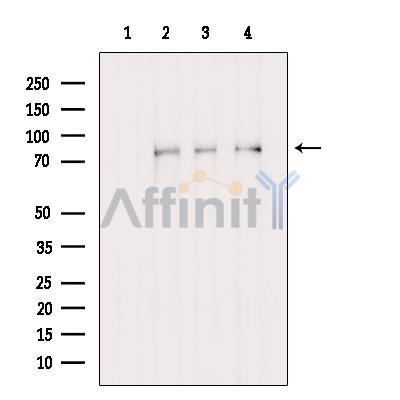FLCN Antibody - #DF12608
| Product: | FLCN Antibody |
| Catalog: | DF12608 |
| Description: | Rabbit polyclonal antibody to FLCN |
| Application: | WB IF/ICC |
| Reactivity: | Human, Mouse, Rat, Monkey |
| Prediction: | Pig, Bovine, Rabbit, Dog, Chicken, Xenopus |
| Mol.Wt.: | 45 kDa,70kDa; 64kD(Calculated). |
| Uniprot: | Q8NFG4 |
| RRID: | AB_2845570 |
Related Downloads
Protocols
Product Info
*The optimal dilutions should be determined by the end user. For optimal experimental results, antibody reuse is not recommended.
*Tips:
WB: For western blot detection of denatured protein samples. IHC: For immunohistochemical detection of paraffin sections (IHC-p) or frozen sections (IHC-f) of tissue samples. IF/ICC: For immunofluorescence detection of cell samples. ELISA(peptide): For ELISA detection of antigenic peptide.
Cite Format: Affinity Biosciences Cat# DF12608, RRID:AB_2845570.
Fold/Unfold
BHD; BHD skin lesion fibrofolliculoma protein; Birt Hogg Dube syndrome protein; Birt-Hogg-Dube syndrome protein; DKFZp547A118; FLCL; Flcn; FLCN_HUMAN; FLJ45004; FLJ99377; Folliculin; MGC17998; MGC23445;
Immunogens
A synthesized peptide derived from human FLCN, corresponding to a region within N-terminal amino acids.
Expressed in most tissues tested, including skin, lung, kidney, heart, testis and stomach.
- Q8NFG4 FLCN_HUMAN:
- Protein BLAST With
- NCBI/
- ExPASy/
- Uniprot
MNAIVALCHFCELHGPRTLFCTEVLHAPLPQGDGNEDSPGQGEQAEEEEGGIQMNSRMRAHSPAEGASVESSSPGPKKSDMCEGCRSLAAGHPGYISHDKETSIKYVSHQHPSHPQLFSIVRQACVRSLSCEVCPGREGPIFFGDEQHGFVFSHTFFIKDSLARGFQRWYSIITIMMDRIYLINSWPFLLGKVRGIIDELQGKALKVFEAEQFGCPQRAQRMNTAFTPFLHQRNGNAARSLTSLTSDDNLWACLHTSFAWLLKACGSRLTEKLLEGAPTEDTLVQMEKLADLEEESESWDNSEAEEEEKAPVLPESTEGRELTQGPAESSSLSGCGSWQPRKLPVFKSLRHMRQVLGAPSFRMLAWHVLMGNQVIWKSRDVDLVQSAFEVLRTMLPVGCVRIIPYSSQYEEAYRCNFLGLSPHVQIPPHVLSSEFAVIVEVHAAARSTLHPVGCEDDQSLSKYEFVVTSGSPVAADRVGPTILNKIEAALTNQNLSVDVVDQCLVCLKEEWMNKVKVLFKFTKVDSRPKEDTQKLLSILGASEEDNVKLLKFWMTGLSKTYKSHLMSTVRSPTASESRN
Predictions
Score>80(red) has high confidence and is suggested to be used for WB detection. *The prediction model is mainly based on the alignment of immunogen sequences, the results are for reference only, not as the basis of quality assurance.
High(score>80) Medium(80>score>50) Low(score<50) No confidence
Research Backgrounds
May be a tumor suppressor. May be involved in energy and/or nutrient sensing through the AMPK and mTOR signaling pathways. May regulate phosphorylation of RPS6KB1.
Phosphorylated. Several different phosphorylated forms exist.
Cytoplasm. Nucleus.
Note: Mainly localized in the nucleus. Colocalizes with FNIP1 and FNIP2 in the cytoplasm.
Expressed in most tissues tested, including skin, lung, kidney, heart, testis and stomach.
Belongs to the folliculin family.
Research Fields
· Environmental Information Processing > Signal transduction > mTOR signaling pathway. (View pathway)
· Human Diseases > Cancers: Specific types > Renal cell carcinoma. (View pathway)
Restrictive clause
Affinity Biosciences tests all products strictly. Citations are provided as a resource for additional applications that have not been validated by Affinity Biosciences. Please choose the appropriate format for each application and consult Materials and Methods sections for additional details about the use of any product in these publications.
For Research Use Only.
Not for use in diagnostic or therapeutic procedures. Not for resale. Not for distribution without written consent. Affinity Biosciences will not be held responsible for patent infringement or other violations that may occur with the use of our products. Affinity Biosciences, Affinity Biosciences Logo and all other trademarks are the property of Affinity Biosciences LTD.


